Optical Fiber Based Mach-Zehnder Interferometer for APES Detection
Abstract
:1. Introduction
2. Experimental Methods and Principle
2.1. Sensor Fabrication and Principle
2.2. APES Film Fabrication
3. Results and Discussion
3.1. Validation of the Dripping Method’s Feasibility
3.2. Validation of the Necessity of Hydroxylation
3.3. Determination of APES Amount
3.4. SEM of the APES-Modified Optical Fiber Surface
4. Conclusions
Author Contributions
Funding
Institutional Review Board Statement
Informed Consent Statement
Conflicts of Interest
References
- Howarter, J.A.; Youngblood, J.P. Optimization of silica silanization by 3-aminopropyltriethoxysilane. Langmuir ACS J. Surf. Colloids 2006, 22, 11142–11147. [Google Scholar] [CrossRef] [PubMed]
- Zhu, C.; Li, S.; Cong, X.; Rudd, C.; Liu, X. The effect of 3-aminopropyltriethoxysilanetreatment on recycled carbon fibers reinforced composites. In Proceedings of the 21st National Conference on Composite Materials (NCCM-21), Inner Mongolia, China, 29 July–1 August 2020. [Google Scholar]
- Bañuls, M.-J.; Puchades, R.; Maquieira, Á. Chemical surface modifications for the development of silicon-based label-free integrated optical (IO) biosensors: A review. Anal. Chim. Acta 2013, 777, 1–16. [Google Scholar] [CrossRef] [PubMed]
- Huertas, C.S.; Calvo-Lozano, O.; Mitchell, A.; Lechuga, L.M. Advanced Evanescent-Wave Optical Biosensors for the Detection of Nucleic Acids: An Analytic Perspective. Front. Chem. 2019, 7, 724. [Google Scholar] [CrossRef] [Green Version]
- Kaur, A.; Kapoor, S.; Bharti, A.; Rana, S.; Chaudhary, G.R.; Prabhakar, N. Gold-platinum bimetallic nanoparticles coated 3-(aminopropyl)triethoxysilane (APTES) based electrochemical immunosensor for vitamin D estimation. J. Electroanal. Chem. 2020, 873, 114400. [Google Scholar] [CrossRef]
- Bharti, A.; Mittal, S.; Rana, S.; Dahiya, D.; Agnihotri, N.; Prabhakar, N. Electrochemical biosensor for miRNA-21 based on gold-platinum bimetallic nanoparticles coated 3-aminopropyltriethoxy silane. Anal. Biochem. 2020, 609, 113908. [Google Scholar] [CrossRef] [PubMed]
- Xu, X.; Song, X.; Nie, R.; Yang, Y.; Chen, Y.; Yang, L. Ultra-sensitive capillary immunosensor combining porous-layer surface modification and biotin-streptavidin nano-complex signal amplification: Application for sensing of procalcitonin in serum. Talanta 2019, 205, 120089. [Google Scholar] [CrossRef] [PubMed]
- Rao, X.; Tatoulian, M.; Guyon, C.; Ognier, S.; Chu, C.; Hassan, A.A. A Comparison Study of Functional Groups (Amine vs. Thiol) for Immobilizing AuNPs on Zeolite Surface. Nanomaterials 2019, 9, 1034. [Google Scholar] [CrossRef] [PubMed] [Green Version]
- Lee, M.R.; Shin, I. Fabrication of chemical microarrays by efficient immobilization of hydrazide-linked substances on epoxide-coated glass surfaces. Angew. Chem. 2005, 44, 2881. [Google Scholar] [CrossRef] [PubMed]
- Han, S. Research on Hg2+ and Pb2+ Evanescent Wave Biosensing Detection Technology Based on Functional Nucleic Acid; Tsinghua University: Beijing, China, 2016. [Google Scholar]
- Han, S.; Zhou, X.; Tang, Y.; He, M.; Zhang, X.; Shi, H.; Xiang, Y. Practical, highly sensitive, and regenerable evanescent-wave biosensor for detection of Hg2+ and Pb2+ in water. Biosens. Bioelectron. 2016, 80, 265–272. [Google Scholar] [CrossRef] [PubMed]
- Ainuddin, N.H.; Chee, H.Y.; Ahmad, M.Z.; Mahdi, M.A.; Abu Bakar, M.H.; Yaacob, M.H. Sensitive Leptospira DNA detection using tapered optical fiber sensor. J. Biophotonics 2018, 11, e201700363. [Google Scholar] [CrossRef] [PubMed]
- Zhang, G.J.; Luo, Z.H.H.; Huang, M.J.; Tay, G.K.I.; Lim, E.J.A. Morpholino-functionalized silicon nanowire biosensor for sequence-specific label-free detection of DNA. Biosens. Bioelectron. 2010, 25, 2447–2453. [Google Scholar] [CrossRef]
- Rong, G.; Najmaie, A.; Sipe, J.E.; Weiss, S.M. Nanoscale porous silicon waveguide for label-free DNA sensing. Biosens. Bioelectron. 2008, 23, 1572–1576. [Google Scholar] [CrossRef] [PubMed]
- De Tommasi, E.; De Stefano, L.; Rea, I.; Di Sarno, V.; Rotiroti, L.; Arcari, P.; Lamberti, A.; Sanges, C.; Rendina, I. Porous Silicon Based Resonant Mirrors for Biochemical Sensing. Sensors 2008, 8, 6549–6556. [Google Scholar] [CrossRef] [Green Version]
- Massad-Ivanir, N.; Shtenberg, G.; Zeidman, T.; Segal, E. Construction and Characterization of Porous SiO2/Hydrogel Hybrids as Optical Biosensors for Rapid Detection of Bacteria. Adv. Funct. Mater. 2010, 20, 2269–2277. [Google Scholar] [CrossRef]
- Grego, S.; McDaniel, J.R.; Stoner, B.R. Wavelength interrogation of grating-based optical biosensors in the input coupler configuration. Sens. Actuators B Chem. 2008, 131, 347–355. [Google Scholar] [CrossRef]
- Gong, J.; Shen, C.; Xiao, Y.; Liu, S.; Zhang, C.; Ding, Z.; Deng, H.; Fang, J.; Lang, T.; Zhao, C.; et al. High sensitivity fiber temperature sensor based PDMS film on Mach-Zehnder interferometer. Opt. Fiber Technol. 2019, 53, 102029. [Google Scholar] [CrossRef]
- Yu, F.; Liu, B.; Zou, Q.; Xue, P.; Zheng, J. Influence of temperature on the refractive index sensor based on a core-offset in-line fiber Mach-Zehnder interferometer. Opt. Fiber Technol. 2020, 58, 102293. [Google Scholar] [CrossRef]
- Zaini, M.K.A.; Lee, Y.-S.; Ismail, N.; Lim, K.-S.; Udos, W.; Zohari, M.H.; Yang, H.-Z.; Ahmad, H. In-fiber Fabry Perot interferometer with narrow interference fringes for enhanced sensitivity in elastic wave detection. Opt. Fiber Technol. 2019, 53, 102021. [Google Scholar] [CrossRef]

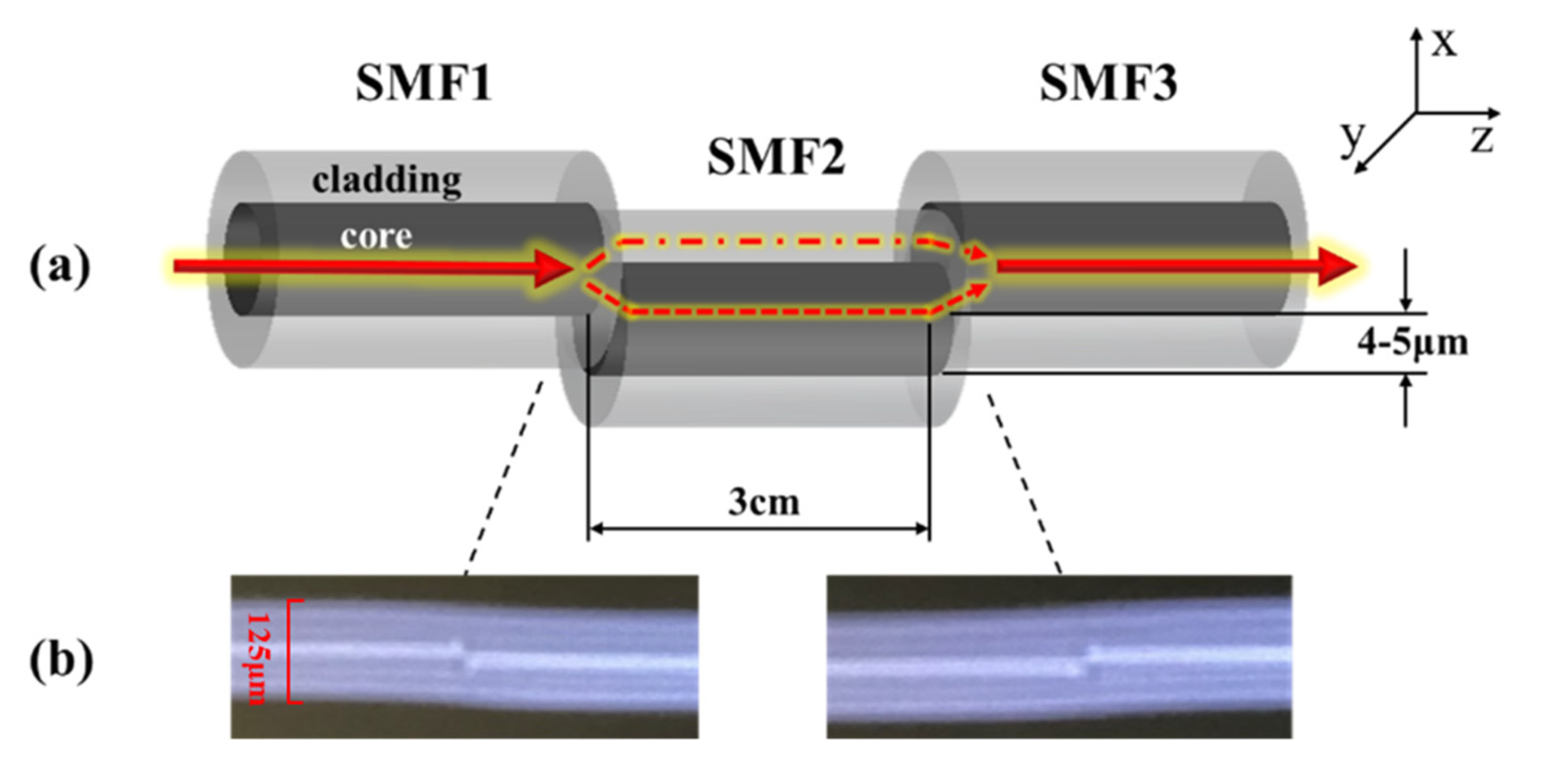
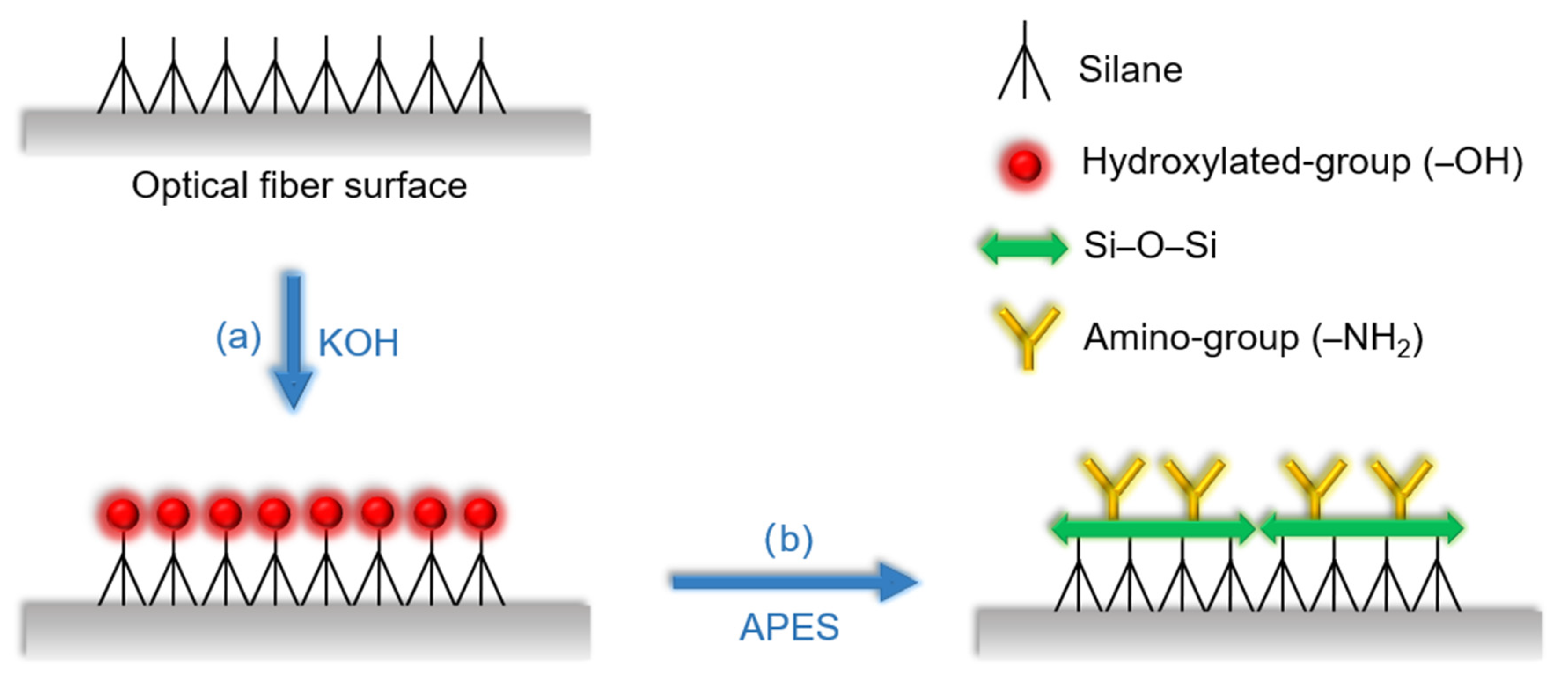
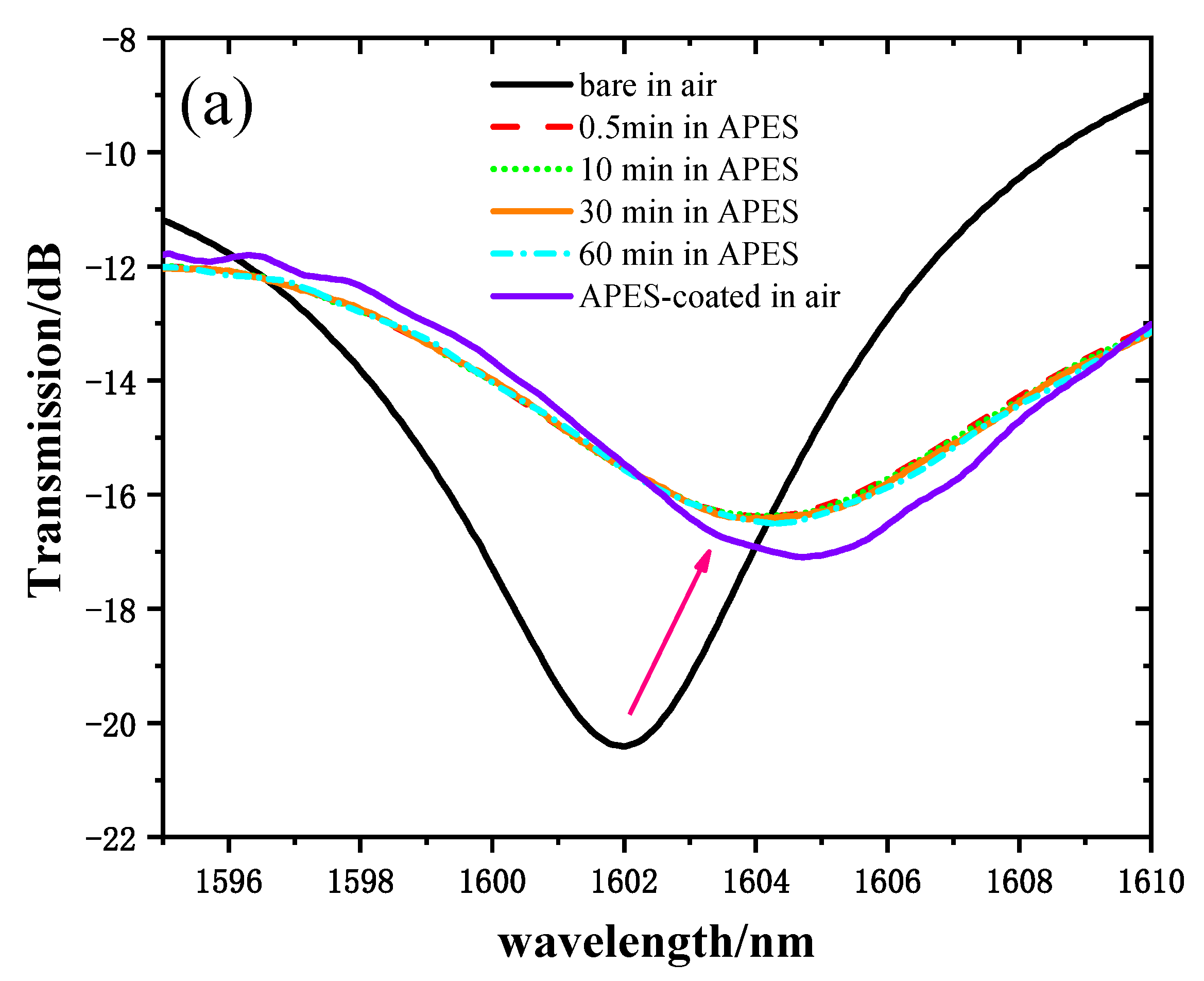
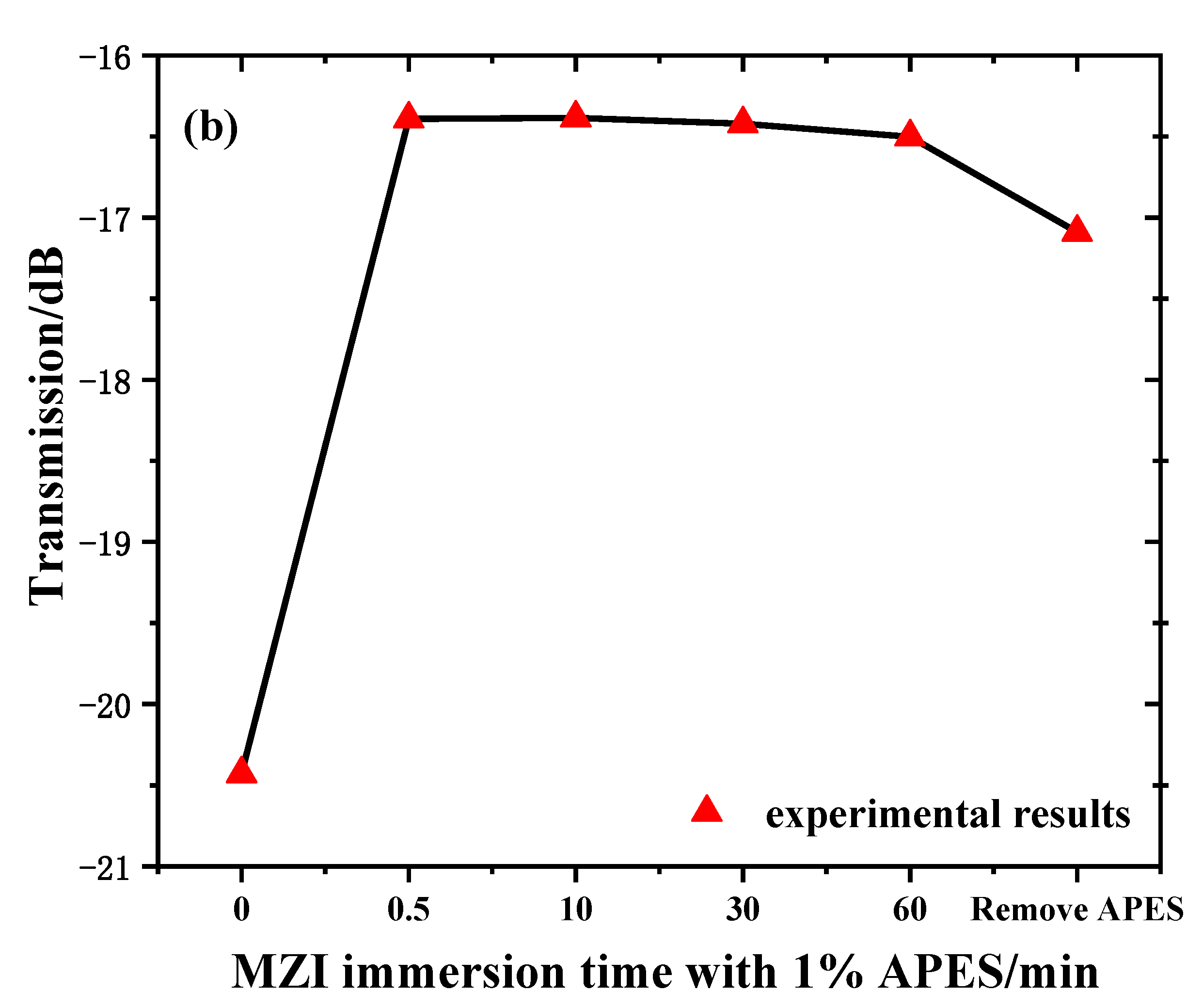
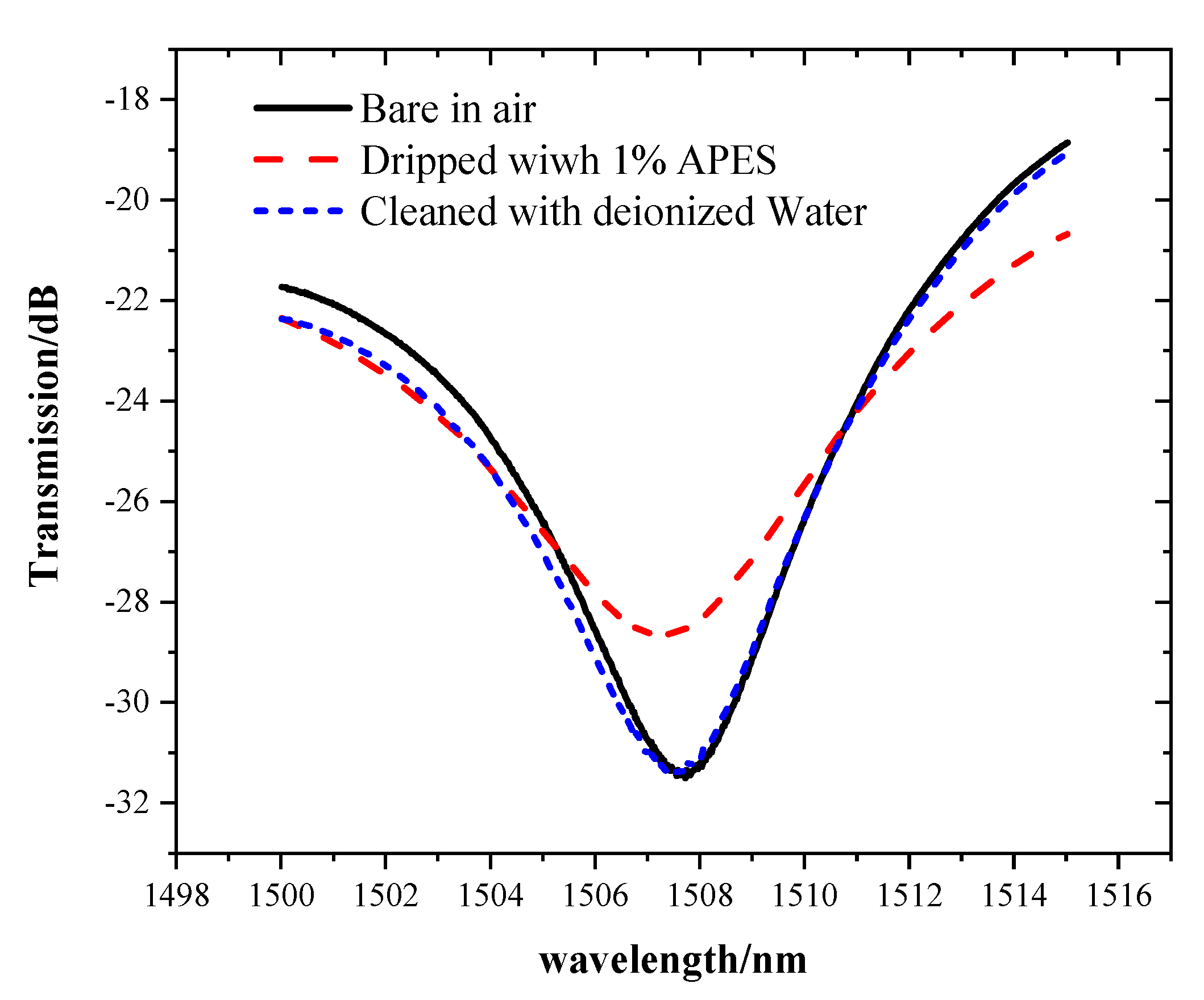



Publisher’s Note: MDPI stays neutral with regard to jurisdictional claims in published maps and institutional affiliations. |
© 2021 by the authors. Licensee MDPI, Basel, Switzerland. This article is an open access article distributed under the terms and conditions of the Creative Commons Attribution (CC BY) license (https://creativecommons.org/licenses/by/4.0/).
Share and Cite
Deng, H.; Chen, X.; Huang, Z.; Kang, S.; Zhang, W.; Li, H.; Shu, F.; Lang, T.; Zhao, C.; Shen, C. Optical Fiber Based Mach-Zehnder Interferometer for APES Detection. Sensors 2021, 21, 5870. https://doi.org/10.3390/s21175870
Deng H, Chen X, Huang Z, Kang S, Zhang W, Li H, Shu F, Lang T, Zhao C, Shen C. Optical Fiber Based Mach-Zehnder Interferometer for APES Detection. Sensors. 2021; 21(17):5870. https://doi.org/10.3390/s21175870
Chicago/Turabian StyleDeng, Huitong, Xiaoman Chen, Zhenlin Huang, Shiqi Kang, Weijia Zhang, Hongliang Li, Fangzhou Shu, Tingting Lang, Chunliu Zhao, and Changyu Shen. 2021. "Optical Fiber Based Mach-Zehnder Interferometer for APES Detection" Sensors 21, no. 17: 5870. https://doi.org/10.3390/s21175870
APA StyleDeng, H., Chen, X., Huang, Z., Kang, S., Zhang, W., Li, H., Shu, F., Lang, T., Zhao, C., & Shen, C. (2021). Optical Fiber Based Mach-Zehnder Interferometer for APES Detection. Sensors, 21(17), 5870. https://doi.org/10.3390/s21175870







